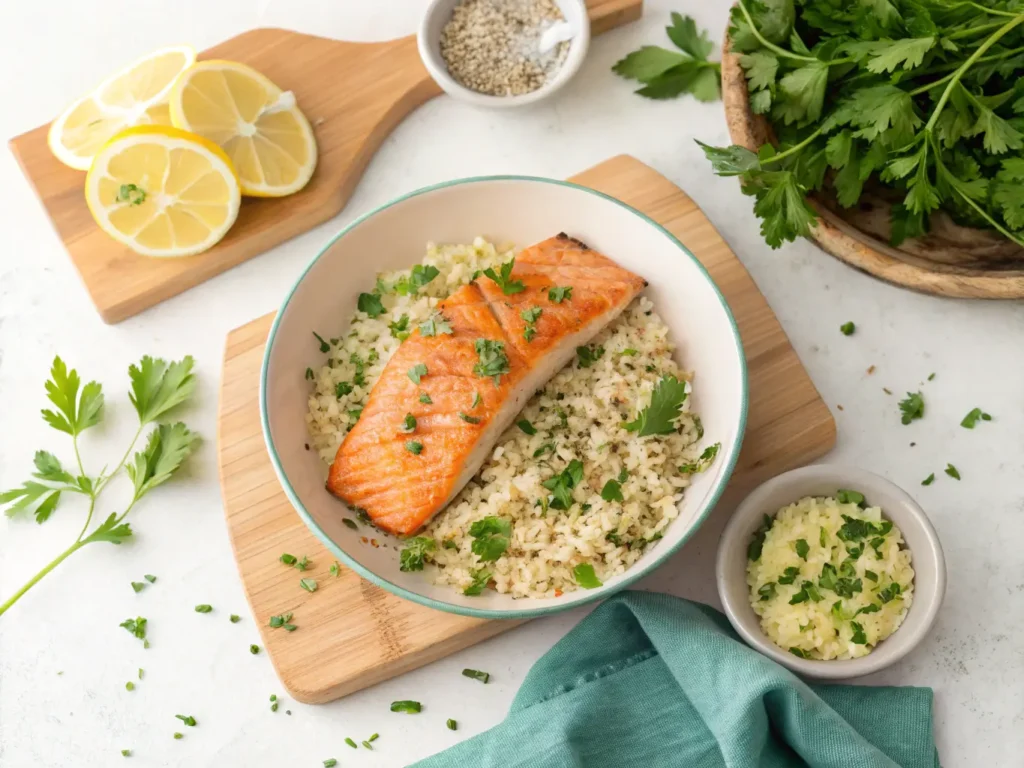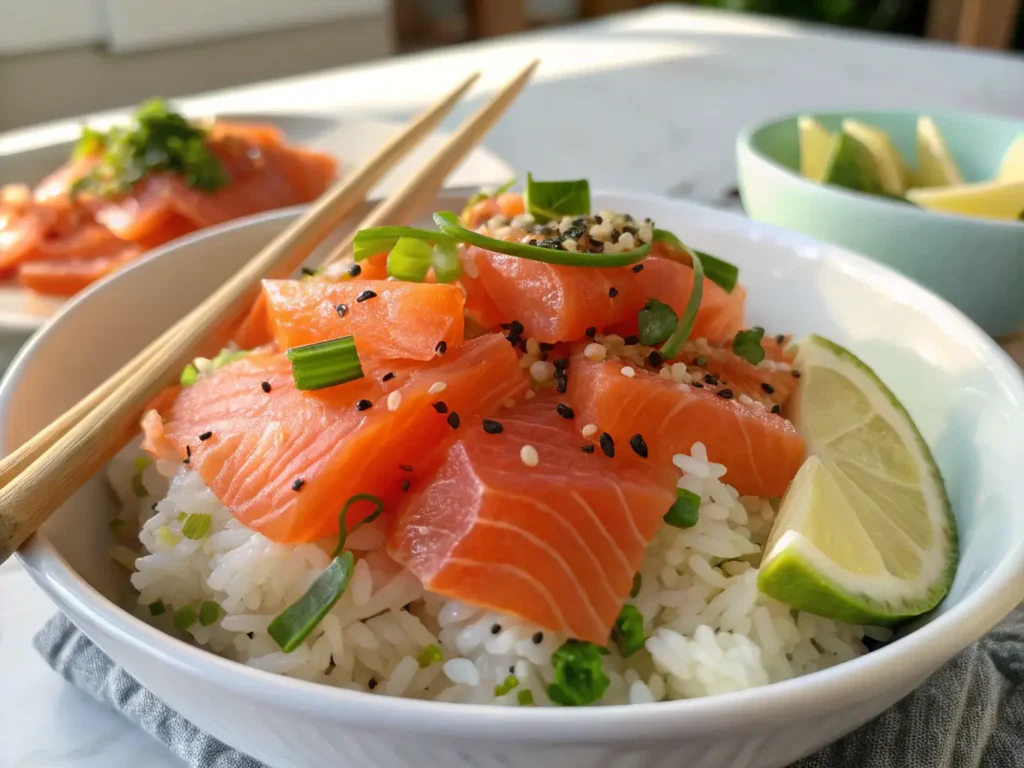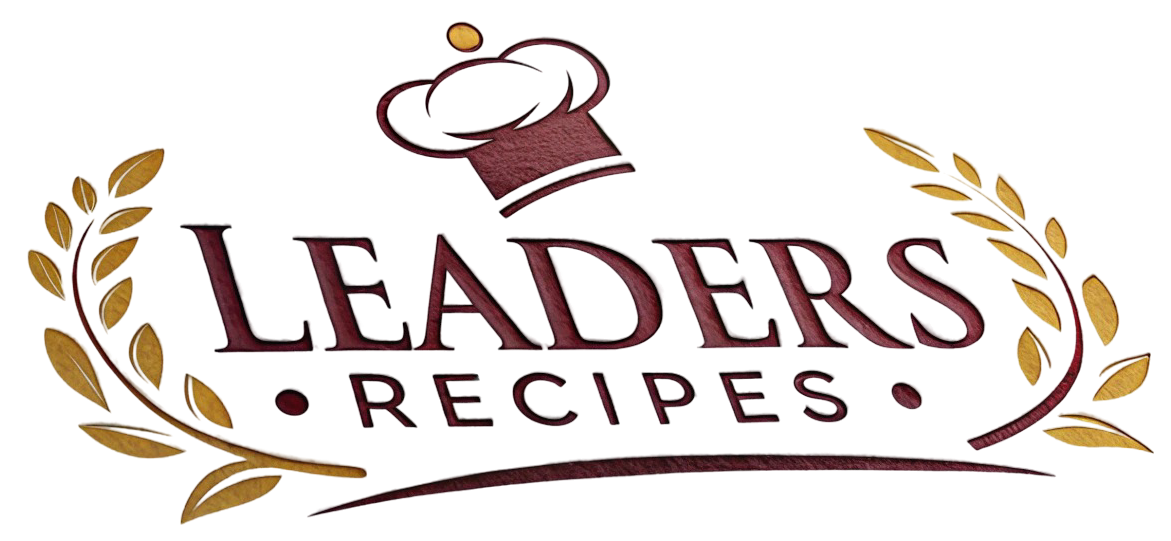Table of Contents
Salmon and rice is a healthy, flavorful, and versatile meal option that works perfectly for weeknight dinners, meal prep, or special occasions. This easy-to-make dish combines the delicate richness of salmon with the satisfying base of rice, creating a meal that’s both nutritious and delicious. Whether you’re a beginner in the kitchen or a seasoned cook, salmon and rice offers a wide range of flavors and customization, allowing you to experiment with different seasonings, sauces, and side dishes.
In this ultimate guide, we’ll walk you through a step-by-step salmon and rice recipe, covering everything from selecting the best salmon fillets to perfecting your rice and creating various mouthwatering variations. Let’s dive into the world of salmon and rice, a go-to meal that brings comfort, health benefits, and versatility to your table.
What is a Salmon and Rice Recipe?
Definition and Key Characteristics
A salmon and rice recipe combines tender, flaky salmon fillets with seasoned rice—often accompanied by vegetables, herbs, and sauces. This dish offers a balanced combination of protein, healthy fats, and carbohydrates. It’s known for its simplicity and adaptability, making it perfect for a variety of dietary needs and personal preferences.
Typically, salmon is cooked by baking, pan-searing, or grilling, and served alongside a bed of rice (such as white rice, brown rice, or jasmine rice). The optional addition of seasonings like garlic, lemon, ginger, and soy sauce elevates the dish, making it even more flavorful and aromatic.
Why It’s So Popular
Salmon and rice is popular because it offers versatility, is easy to prepare, and provides great nutritional benefits. You can prepare this dish in under 30 minutes, making it the perfect choice for busy weeknights. It’s also a well-rounded meal that fits various dietary restrictions, including low-carb, gluten-free, and paleo diets. Plus, you can customize it with different flavors, spices, and sauces, so you can enjoy a new variation every time.
Salmon and Rice Variations
There are numerous ways to customize a salmon and rice recipe. From baked salmon with simple white rice to teriyaki salmon rice bowls, this meal can be adapted to suit any taste. You can add a variety of vegetables, top with sauces like teriyaki, garlic butter, or salsa, and experiment with different types of rice, such as quinoa, cauliflower rice, or sushi rice.
Health Benefits of Salmon and Rice
High in Protein
Salmon is an excellent source of high-quality protein, which is essential for muscle growth, repair, and maintaining overall health. Rice complements salmon by providing carbohydrates, making this dish a complete meal. Together, salmon and rice provide a well-rounded nutrient profile that supports energy, growth, and recovery.
Omega-3 Fatty Acids
Salmon is rich in omega-3 fatty acids, which are known for their heart-health benefits. These healthy fats help reduce inflammation, improve brain function, and support joint health. Including salmon in your diet regularly can also help lower cholesterol and improve cardiovascular health.
Essential Nutrients
Aside from omega-3s, salmon provides other essential vitamins and minerals, including Vitamin B12, Vitamin D, and selenium. Rice, on the other hand, is a great source of complex carbohydrates that fuel your body with sustained energy throughout the day. Together, salmon and rice provide a variety of nutrients that contribute to a balanced diet.

Ingredients for a Salmon and Rice Recipe
Core Ingredients
- Salmon fillets (fresh or frozen)
- Rice: Choose between white rice, brown rice, jasmine rice, or sushi rice depending on your preferences.
- Olive oil: For cooking the salmon and adding moisture to the rice.
- Salt and pepper: Essential for seasoning both the rice and the salmon.
Flavor Boosters
To enhance the flavor of your salmon and rice recipe, consider using the following ingredients:
- Garlic: Adds a savory kick and depth to the dish.
- Lemon juice: Adds brightness and acidity, perfectly complementing the richness of the salmon.
- Soy sauce: Adds a savory, umami flavor to the rice and salmon.
- Honey: For a touch of sweetness, especially when making glazed salmon.
- Ginger: Adds a fresh, aromatic kick to the rice or salmon.
- Herbs: Use dill, parsley, or green onions to garnish the dish for added flavor.
Optional Add-Ins
- Vegetables: Consider adding broccoli, carrots, spinach, or asparagus as sides or mixing them into the rice for extra nutrition.
- Sauces: Teriyaki, garlic butter, or chili sauce can be drizzled over the salmon or rice for an extra burst of flavor.
- Seasonings: Enhance the taste with paprika, chili flakes, or cumin for a spicy kick.
Equipment Needed to Make Salmon and Rice
Essential Cooking Tools
- Large skillet: For pan-searing or cooking the salmon.
- Pot: To cook the rice using your preferred method (stovetop, rice cooker, or Instant Pot).
- Baking sheet: For baked salmon.
- Foil: For wrapping the salmon during baking to retain moisture.
- Spatula: To flip the salmon or stir the rice.
Optional Accessories
- Rice cooker: Perfect for cooking rice to fluffy perfection without the need for constant attention.
- Food thermometer: Ensures the salmon reaches the ideal temperature of 145°F for proper doneness.
Step-by-Step Instructions for Making Salmon and Rice
Step 1: Preparing the Rice
Start by rinsing the rice under cold water to remove excess starch. This step ensures the rice cooks to a fluffy consistency without being sticky. If you’re using a rice cooker, simply add the rinsed rice, water, and salt, and let the cooker work its magic. For stovetop cooking, combine the rice with water in a pot and bring it to a boil. Reduce the heat, cover, and let it simmer for about 15-20 minutes, or until all the water is absorbed. Fluff the rice with a fork once it’s done.
Step 2: Preparing the Salmon
Season the salmon fillets with salt, pepper, garlic, and lemon juice. If you’re marinating the salmon, mix the ingredients in a small bowl and let the fillets sit for at least 15 minutes to absorb the flavors.
Step 3: Cooking the Salmon
- Baking: Preheat the oven to 400°F (200°C). Place the seasoned salmon on a baking sheet lined with foil. Bake for 12-15 minutes, or until the salmon flakes easily with a fork.
- Pan-searing: Heat a large skillet with olive oil over medium heat. Add the salmon fillets and cook for about 4-5 minutes per side, or until golden brown and cooked through.
- Grilling: Preheat the grill and cook the salmon fillets for 4-5 minutes per side, ensuring they are cooked through with a slightly crispy exterior.
Step 4: Plating the Rice and Salmon
Once the rice is ready, serve it as a base on your plate. Place the cooked salmon on top, and garnish with your choice of herbs or vegetables. You can drizzle soy sauce or a homemade garlic butter sauce over the top for extra flavor.
Step 5: Garnishing and Serving
To finish off your dish, add a wedge of lemon, a sprinkle of fresh parsley, or a drizzle of honey for a balanced sweet and savory taste. Serve alongside steamed vegetables or a side salad to complete the meal.
Cooking Methods for Salmon and Rice
Baked Salmon and Rice
Baking the salmon in foil or parchment paper ensures the fish stays moist and tender. This method is hands-off and easy, making it ideal for busy weeknights.
Pan-Seared Salmon with Rice
For crispy salmon skin and rich flavor, pan-searing is a great method. It creates a nice contrast between the crispy skin and tender, flaky flesh.
Air-Fried Salmon and Rice
If you’re looking for a healthy, crispy option, air-frying salmon is a great choice. It gives the salmon a crispy exterior while keeping the inside moist.
Grilled Salmon with Rice
Grilling adds a smoky flavor to your salmon, and it’s perfect for summer meals or BBQ-style dinners.
Tips for Perfect Salmon and Rice
Choosing Fresh Salmon
When selecting salmon, look for fillets with vibrant color and moisture. The flesh should be firm and slightly translucent. Fresh salmon will have a clean, ocean-like smell and shouldn’t be fishy.
Preventing Overcooked Salmon
To avoid overcooking the salmon, use a food thermometer to check that it reaches an internal temperature of 145°F (63°C). Remove the salmon from the heat just before it reaches the target temperature, as it will continue to cook slightly after you take it off the heat.
Fluffy, Perfect Rice Every Time
Use the correct water-to-rice ratio (typically 2 cups water to 1 cup rice) for perfect rice. If you’re using a rice cooker, follow the machine’s instructions for the best results.
Variations of Salmon and Rice Recipe
Classic Garlic Butter Salmon and Rice
A simple yet delicious version featuring garlic butter sauce drizzled over pan-seared or baked salmon.
Teriyaki Salmon Rice Bowl
Flaky salmon with teriyaki sauce, served over rice and topped with sesame seeds and green onions.
Honey Garlic Salmon and Rice
A sweet and savory option featuring honey and garlic-glazed salmon paired with steamed rice.
Spicy Chili Salmon Rice Bowl
Add a kick with chili flakes, hot sauce, and garlic-infused rice for a spicy twist.
Sushi-Inspired Salmon and Rice Bowl
Create a deconstructed sushi bowl with salmon, sushi rice, avocado, and nori.
Serving Suggestions for Salmon and Rice
As a Weeknight Dinner
Serve your salmon and rice with a side of steamed vegetables like broccoli, green beans, or carrots for a well-rounded meal.
As a Meal-Prep Option
Portion out salmon and rice into meal prep containers for easy lunches or dinners throughout the week.
Perfect Pairings
Pair your dish with miso soup, garlic bread, or a side salad for a complete, satisfying meal.
Meal Prep and Storage Tips
Can You Make Salmon and Rice Ahead of Time?
Yes, both the rice and salmon can be prepared ahead of time. Store the rice and cooked salmon separately in airtight containers in the fridge for up to 3 days.
How to Store Leftovers
Store leftover salmon and rice in an airtight container in the fridge for up to 3 days.
Reheating Instructions
To reheat salmon and rice, use the microwave, stovetop, or oven. Reheat the salmon at a low temperature to avoid drying it out.

Health and Customization Options
Healthier Salmon and Rice
Make this dish healthier by using brown rice or quinoa instead of white rice and opting for a leaner cut of salmon.
Keto and Low-Carb Salmon with Cauliflower Rice
For a low-carb version, substitute regular rice with cauliflower rice to keep your meal keto-friendly.
Vegan and Plant-Based Alternatives
If you prefer a plant-based version, replace salmon with tofu, tempeh, or chickpeas.
Common Mistakes to Avoid
Overcooking the Salmon
To prevent dry salmon, don’t overcook it. Use a food thermometer to check doneness.
Undercooking the Rice
Ensure that the rice is fully cooked by following the correct water-to-rice ratio.
Overcrowding the Skillet
When pan-searing salmon, avoid overcrowding the skillet. Give the fillets space to cook evenly and achieve crispy skin.
FAQs
Can I use frozen salmon for this recipe?
Yes, frozen salmon can be used, but make sure to thaw it properly before cooking.
How do I know when salmon is done?
Salmon is done when it reaches an internal temperature of 145°F (63°C) or flakes easily with a fork.
Can I use brown rice instead of white rice?
Yes, brown rice is a great alternative and offers more fiber and nutrients.
What’s the best way to reheat salmon and rice?
Reheat salmon and rice on the stovetop, microwave, or in the oven for best results.
Can I freeze cooked salmon and rice?
Yes, both salmon and rice can be frozen for future meals.
How do I keep salmon from sticking to the pan?
Use oil or butter in the pan and ensure the salmon is dry before cooking.
Conclusion
The salmon and rice recipe offers a healthy, versatile, and delicious meal that you can enjoy at any time of day. Whether you prepare it for weeknight dinners, meal prep, or a special occasion, this dish provides endless possibilities for customization. Experiment with different seasonings, sauces, and rice types to make the recipe your own and enjoy a nutritious, flavorful meal every time.

